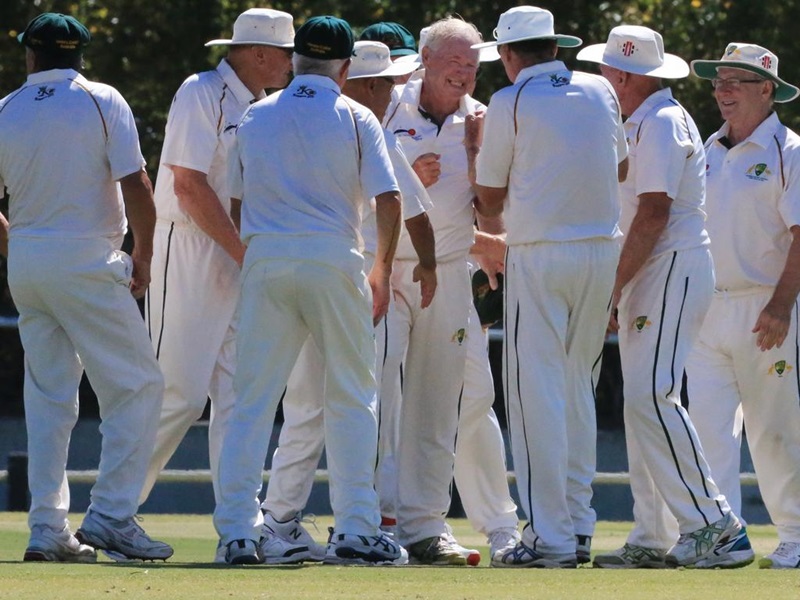The History of Cricket for the 60s, 70s, and 80s year old players
Joel McGlynn | May 11, 2024

Have I got your attention? Good, as this article is for all cricket lovers!
Let's be clear from the outset: we are not discussing cricket players from the 1960s, 1970s, or 1980s. We’re talking about people today who are still playing cricket in their 60s, 70s, and even 80s. That's right, more than a thousand cricketers, or perhaps even closer to two thousand, are still playing cricket on a weekly basis throughout Australia and England, plus a smaller number in New Zealand and other parts of the world. In our home state of Victoria, we currently have some 700 over-60 cricketers playing in our own Cricket Association on a regular basis, every Wednesday and Sunday during the cricket season. Included in this number are 200 Over 70s players.
You may ask why. You have to go back to the mid- to late 1930s, when the earliest of our current cricketers were born. Television didn’t commence in Australia until 1956, so newspapers and wireless (radio) were the only ways you received your daily news. Sure, if your family could afford it, you went to the movies once a week and received international news headlines. Growing up, the only real sport for a young schoolboy was cricket or tennis in the summer, and football (Australian Rules) in the winter (in Victoria).
As a young schoolboy, I vividly recall my father allowing me to stay up late to watch the first ball of an England/Australia Test match. It was probably in 1948 at Trent Bridge. We had our national super heroes playing: Sid Barnes, Arthur Morris, Don Bradman, Keith Miller, Lindsay Hassett, Ray Lindwall, and co. The great enemies were Len Hutton, Cyril Washbrook, Bill Edrich, Jim Laker, Alec Bedser, and anyone else England selected.
Late in the in the afternoon, after school, or on the weekend, the wooden fruit box or garbage bin would go out into the middle of the street. Two teams would be selected from kids who lived up and down the street, and the test match would be played all over again. “Over the fence was a six and out, hitting the fence on the bounce was a four." What fabulous matches we played!
It wasn’t until we reached around twelve years of age and were changing from primary school to a college, high school, or technical school that we officially started to play cricket, as most schools had a cricket team, and most of the local suburban churches had cricket teams. Under-16s, Under-18s, and Seniors.
So that’s where most of us got our cricket grounding by playing in these junior competitions on a malthoid wicket with a hard cork ball, or on matting with a brand new two-piece leather ball. The majority of us continued to play what we called park cricket until our mid- to late twenties, and a small group of more talented players went on to play Sub or District Club Cricket (fourths through to Seniors), then possibly State Cricket, then the ultimate of playing for Australia. Some players of course, still continued to play on into there 50s and longer in park cricket and some of course, still do so.
The Game Have you ever stopped to tell someone who has no idea, the rules of the game of cricket? It was difficult back then, when we played two-day matches on consecutive Saturdays, never Sundays, now we still have these, plus ODIs, Twenty20s, the Big Bash and of course, 5 day Test matches. Have you thought about the cricket gear? In times past, you had a short or long handled cricket bat. Now we have dozens of brands, all different thicknesses, and different weights. We used to have two and four piece red cricket balls, and as a junior, a red cork ball. Now we have two and four piece red balls with a large number of brands, or if you prefer, pink, orange, green or white? Cricket pads have gone from canvas with cane inserts, to the latest ultra-light polyester pads. Batting gloves, helmets, cricket shoes (spikes or rubber soles) – what a choice!
But one thing has remained the same since the early beginnings, is the way our game is played.
How do you explain to someone how it feels to hit a ball sweetly in the middle of the bat, or how to defend your wicket off a bowler steaming in, or spinning the ball into or away from your pads?. How do you explain how it feels to bowl the ball twenty-two yards down the pitch and land it exactly where you want it, knocking a stump out of the ground, or the ball being caught by one of your fellow team mates? How do you explain how it feels if the batsman strikes the ball hard and you put out your hand and it sticks? All these are individual things, however add this up to being in a team of 11 or 12 players all sharing the same buzz of excitement. And at the end of the day, coming off the ground, win, lose, or draw and shaking hands with your opponents, enjoying the camaraderie on and off the field.
Do you ever stop to think of things that helped shape Australia back in the early days? I think a lot had to do with our youth and particularly team sports. Sure we were more disciplined by stricter parents, teachers, etc. but if it wasn’t for junior football and cricket what would our young people have done with themselves. Team sports brought young people together and the camaraderie that developed has lasted through the years and we’ve noticed that with Over 60s cricket, players are renewing friendships with fellow cricketers they might not have caught up with in 30 or 40 years, especially those that gave cricket away, back in the 50s, 60s and 70s.
Fortunately for all of us, cricket is a truly International sport. Cricketers around the world strive to abide by the MCC ‘Spirit of Cricket’ Laws.
“Cricket is a game that owes much of its unique appeal to the fact that it should be played not only within its Laws, but also within the Spirit of the Game. Any action which is seen to abuse this Spirit causes injury to the game itself”. As a result, cricketers right around the world are increasingly aware they should not merely obey the game’s Laws, but safeguard its Spirit for future generations of boys and girls.








